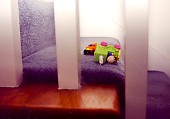| Alliance Consulting International |
|
||||||
 |
|||||||
| A message from Enrique |
|
|
| Big Changes in Lead-based Paint Rules for 1999... | ||
| Safety and Telecommuting: Working safely at home! |
||
| Eyestrain: A Repetitive Motion Injury | ||
| FYI | ||
| ECO-AWARENESS CORNER | ||

A message from Enrique: |
||
| Welcome to Pulse Point | ||
|
||
BIG CHANGES IN LEAD-BASED PAINT RULES FOR 1999: ARE YOU READY?
 All construction projects involving pre-1978 residential housing where lead-based paint is disturbed will require special inspection, risk assessment and work control practices, starting on March 1, 1999. Even those outside the construction trades need to be aware of the guidelines and regulations for working with lead-based paint issued by EPA, OSHA, HUD (Housing and Urban Development) and state agencies.
All construction projects involving pre-1978 residential housing where lead-based paint is disturbed will require special inspection, risk assessment and work control practices, starting on March 1, 1999. Even those outside the construction trades need to be aware of the guidelines and regulations for working with lead-based paint issued by EPA, OSHA, HUD (Housing and Urban Development) and state agencies.
Safety and Telecommuting:
Working safely at home!
 Elizabeth, a thirty-eight year old information systems division manager with 5 years seniority, has been telecommuting from home two days a week for the last nine months. An efficient, dedicated and responsible employee, she negotiated this arrangement directly with the company's CEO, as part of a package to keep her from accepting a competitor's offer. She felt that working from home would bring balance to her life, by allowing her to spend the 90-minute daily commute from her 50-hour a week job with her family instead. Management saw it as an opportunity to retain a key employee and to evaluate if telecommuting could also work for others.
Elizabeth, a thirty-eight year old information systems division manager with 5 years seniority, has been telecommuting from home two days a week for the last nine months. An efficient, dedicated and responsible employee, she negotiated this arrangement directly with the company's CEO, as part of a package to keep her from accepting a competitor's offer. She felt that working from home would bring balance to her life, by allowing her to spend the 90-minute daily commute from her 50-hour a week job with her family instead. Management saw it as an opportunity to retain a key employee and to evaluate if telecommuting could also work for others.
Eyestrain: A Repetitive Motion Injury
 After working at your computer terminal for two to three hours straight, do you experience any of these symptoms? Dry eyes, blurred vision, itchy or burning eyes and headaches, as well as shoulder and neck pain, backaches and fatigue? If you do, you are not alone. You could be suffering from Computer Vision Syndrome, which results from overuse of the small muscles of the eye. In fact, this is a repetitive motion disorder. A 1991 survey of optometrists indicated that 10 million people get eye exams due to computer eyestrain annually. This is 40 times greater than the number of carpal tunnel syndrome cases and other cumulative trauma disorders in a year.
After working at your computer terminal for two to three hours straight, do you experience any of these symptoms? Dry eyes, blurred vision, itchy or burning eyes and headaches, as well as shoulder and neck pain, backaches and fatigue? If you do, you are not alone. You could be suffering from Computer Vision Syndrome, which results from overuse of the small muscles of the eye. In fact, this is a repetitive motion disorder. A 1991 survey of optometrists indicated that 10 million people get eye exams due to computer eyestrain annually. This is 40 times greater than the number of carpal tunnel syndrome cases and other cumulative trauma disorders in a year.
FYI
Men At Work Get Injured One And One-Half Times More Often Than Women
The US workers with the highest risk of injuries are young and male. How does your own workplace compare?
Of the 3.3 million persons aged 16 years or older who were treated for non-fatal occupational injuries in hospital emergency departments during 1996, 69% were men and 31% were women. This is according to results of the National Electronic Injury Surveillance System (NEISS) conducted by NIOSH, the National Institute of Occupational Safety and Health of the Centers for Disease Control.
The data were calculated as "employee-based", referring to numbers of injuries per 100 workers, and "hour-based" indicating injuries per 100 full-time equivalents (FTE). This corrects for the fact that many women and younger and older workers are more likely to work part-time. Based on hours worked, men were injured at a rate of 3.3 per 100 FTE, while women had a rate of 2.1 per 100 FTE, which works out to 1.57 injured men for every injured woman.
The survey found that men and women aged 18-19 years had the highest injury rates of all age groups. After age 19 the injury rates dropped as the workers got older. Men under age 25 had a rate of 6.7 per 100 FTE, almost four times higher than men older than 45, who had the lowest rate at 1.7 injuries per 100 full-time equivalents worked. Among women, those under 20 had the highest injury rate (4.4 per 100 FTE), compared to those aged 65-74, who accumulated only 1.2 injuries per 100 FTE. However, men aged 65 and older were injured less often than same age women.
The most common sites of injuries were hands and fingers (30% of total), half of them lacerations. The most common types of overall injuries were sprains and strains (27%), lacerations (22%) and contusions/hematomas (20%). Sprains and strains to the back, groin and trunk represented 12% of all cases treated in emergency rooms.
The 1996 NEISS survey is the first conducted since 1983. In general, both survey years showed similar estimates for the risk of non-fatal injury in the working population. NEISS statistically selects hospitals across the US and its territories and is the only survey that breaks down non-fatal occupational injuries by industry type, occupation, sex and age group. Annual statistics collected from employer surveys by the Bureau of Labor Statistics (BLS) showed a total of 6.2 million injuries and illnesses in the private sector in 1996. The BLS survey includes illnesses and all forms of medical treatment but may exclude the self-employed or farms with fewer than 11 employees. For more information on the NEISS survey, contact CDC-NIOSH at (800) 356-4674 or visit their web site at http://www.cdc.gov.niosh/homepage.html.
ECO-AWARENESS CORNER
Show-And-Tell
- Cut an apple (the world) into quarters. Set aside three of them. These represent the oceans.
- Take the ¼ remaining and slice it in half. Set aside one of the halves. These are the uninhabitable swamps, deserts, high mountains, etc.
- The 1/8 left is where we humans live, but not necessarily where we farm. Cut this piece into 4 sections. Set aside 3 of them. They are the too rocky, wet, cold, or steep to grow on, but good for houses, parking lots, streets, malls, etc.
- Take the 1/32 left and peel it very carefully. This represents the farmable surface topsoil of the planet. This thin skin is less than 5 feet deep.
- You may now eat the rest, but save this tiny piece, and treat it as if your life depends on it.
From Band Tales, newsletter of the Palomar Audubon Society.
....continued from top
BIG CHANGES IN LEAD-BASED PAINT RULES FOR 1999: ARE YOU READY?
What do you need to know about these rules? What kind of changes do you have to make if you are in the construction and painting trades? How do these rules affect work done in non-residential projects, such as office buildings, hospitals, and schools? What are your legal liabilities as a contractor, building owner or facility manager when directing or supervising work that disturbs lead-based paint? These are some of the questions you need to answer. While there is much to know about the lead-based paint (LBP) issue, here are some basic facts and simple rules to follow, as regulations move from a federal housing issue to a state and local requirement for all construction and renovation projects.
What are the drivers?
Protecting children from lead poisoning is behind the LBP regulations. Lead exposure at very low levels can have serious long-term health consequences. In children, it can impair growth and development, affect learning ability and cause hearing loss. Lead can also cause neurological damage in the developing fetus and result in birth defects.
Lead affects adults too. It builds up slowly in the body over time and is difficult to get rid of. The more lead in your system, the more likely harm will occur. Lead affects the brain, nervous system, kidneys, and blood. It can cause anemia, affect male hormones and lower the sperm count. Some of the symptoms of lead poisoning include tiredness, headaches, trouble concentrating, irritability, muscle or joint pains, weakness, stomach aches, poor appetite, constipation and diarrhea. At higher levels it can raise blood pressure, cause seizures, coma, and possibly death.
Where is lead found?
The risk of lead exposure comes from a variety of sources, including lead-based paint, environmental lead (from the days of leaded gasoline), lead in drinking water, lead-containing home remedies, glazed earthenware, consumer products, and work-related sources (smelting, welding, etc.). For infants and young children who spend most of their time at home or day care, lead-based paint is the major source of exposure. It commonly comes from touching lead-contaminated surfaces, putting their hands in their mouths and ingesting the lead dust, soil, or paint chips.
What do I need to know if I work in construction?
It varies by state. Federal OSHA, EPA and HUD rules apply in all states, except those with approved state plans, such as California. In many instances the federal and state requirements are the same, but a few important differences do exist. You should check with your own state agencies to be sure. Also, some cities and counties, such as San Francisco, have issued their own ordinances. The attached Lead-Based Paint Regulatory Matrix shows key requirements of federal OSHA, EPA and HUD as well as California agencies, including Cal-OSHA and the Department of Health Services (Cal-DHS). For a more complete analysis consult the regulatory references at the end of the table and call your local agencies.
How can I navigate through the regulatory maze?
In looking at the LBP issue, it helps to see it as an overlapping patchwork of regulations focusing on different target groups. For example, while OSHA focuses on protecting your workers, the required work practices -such as using HEPA vacuum and containment on a job site to reduce dust - help make sure the contractor leaves a clean place for the residents. In this way, the same practice protects the health of the worker and the residents, as well as the liability of the building owner and the contractor.
What are some key issues to consider?
The LBP regulations and guidelines are complex and still undergoing changes. However, two of the key issues to consider are trigger tasks and abatement work. Let us look more closely at each of these.
Trigger Tasks
OSHA believes that some common construction practices have the potential to generate large quantities of airborne lead above the permissible exposure limit (PEL). These are called trigger tasks and are classified in three levels. Task 1 level includes dry scraping, sanding, using heat guns, using equipment with HEPA attachment, etc. These require half-face air purifying respirators. Task 2 activities include rivet busting, using non-HEPA attachments, and cleanup of dry abrasive blast residue, which may result in higher exposures than level 1 tasks. They require use of a full-face air-purifying respirator or air supplied or PAPR. Trigger Task 3 activities with higher expected exposures include abrasive blasting, welding, torch cutting, etc., and require use of a supplied air pressure demand respirator. All trigger tasks automatically mandate a number of work procedures such as employee training, hand-washing facilities, wearing protective clothing and respirators, and blood lead testing. Remember that the main issue for OSHA is exposure above the PEL during trigger tasks. Therefore, only if exposure assessment demonstrates that these levels are not reached, can you drop the mandatory requirements when performing trigger tasks.
Abatement
The two ways to control LBP hazards are interim controls and abatement. The main difference is that one is temporary while the other is permanent. According to HUD guidelines, an abatement method is intended to last 20 years or more. The four methods of abatement are: paint removal; enclosure of the lead-painted surface; removal and replacement of lead paint structure, and encapsulation. However, at this time HUD does not consider encapsulation an abatement method due to questions over the 20-year reliability of present techniques. It is now considered an interim control. Other interim controls include: cleaning surfaces to reduce lead dust; repairing pitted surfaces; paint film stabilization; protecting impact and friction surfaces; special cleaning, and education. The distinction is important because EPA and Cal-DHS do not require certification for those performing work intended to last less than 20 years. Certification issues are also very important, not only for abatement workers and supervisors, but also for those conducting testing, risk assessments, inspections, and clearance sampling.
What to do next
The first thing is to figure out which of these regulations apply to your situation. The attached regulatory matrix can help. Maybe you are not in construction or painting, but are a building owner or manager. If your building is post-1978, the lead issue is probably not very important to you. If it is older, but is not a public access building or housing, then the issue becomes one of potential liability, rather than regulatory requirement. The next thing is to become more informed. A number of resources are available through EPA, OSHA, HUD and California's DHS, which can provide you with more information. We are including some Internet sites at the end of this article. You can also contact your company's health, safety and environmental specialist or your industrial hygiene consultant, for advice on your specific situation. Finally, you should plan the changes needed to reach compliance by the target dates. We hope the information presented here will be a good starting point.
Internet sites
- California Department of Health Services: www.childlead.com. DHS also recommends www.parentsplace.com/readroom/lead/index.html for information on health effects
- Consumer Product Safety Commission: www.cpsc.com
- National Lead Information Center Clearinghouse: www.nsc.org/ehc/lead.htm
- National Lead Service Providers' Listing System: www.leadlisting.org/
- US Department of Health and Human Services: www.os.dhhs.gov/
- US Department of Housing and Urban Development: www.hud.gov/lea/leahome.html
- US Environmental Protection Agency: www.epa.gov/opptintr/lead
- US Occupational Safety and Health Administration: www.osha-slc.gov/STLC/lead/
LEAD-BASED PAINT REGULATORY MATRIX
....continued from top
Safety and Telecommuting:
Working safely at home!
The company authorized Elizabeth to buy a computer, a printer-scanner-fax machine, and an ergonomic chair. She already had a desk and a spare bookcase in the upstairs guest bedroom. She put in a second phone line at company expense to use with the fax/modem.
Things were going very well. Her efficiency had improved, productivity in her department was up and morale was high. That is, until she injured her back.
She explained that she slipped and fell while going up the stairs at home carrying a file box delivered by courier from the office. It seems she stepped on a child's toy and lost her balance. Her personal physician attended her and gave her a 14-day disability. This will be followed by physical therapy and periodic monitoring. Her return to work permit will likely include restrictions, such as not working in a sitting position for extended periods. She will need as much rest time as work time while she recuperates. The prognosis for full recovery is favorable, but the timing is uncertain.
At a management meeting to discuss the case, the company's risk manager estimates the initial cost of this accident, including benefits, lost workdays and medical treatment at $35-50,000. Follow up treatment and a possible increase in the worker's compensation modifier will likely raise the total cost. There is also no assurance that Elizabeth will be able to work full-time for the foreseeable future. She recommends replacing her.
Legal counsel is not so sure. He wants to consider seeking subrogation -recovery against a third party who caused the accident- from Elizabeth's homeowner's insurance policy to recover at least part of the worker's compensation benefits. The issue of negligence will come up.
Everyone turns to the health and safety manager. What does our telecommuter safety policy say? Do we even have a home-worker safety program in place? Did you do a hazard assessment? Did Elizabeth receive safety training for home-based work? Did we conduct a home inspection prior to approving her new status? Are we doing an incident investigation at her home? What do you have to say?
If you have telecommuters at work, you may want to start by finding answers to these and other questions, such as: What are the safety and health hazards for a work-at-home employee? What safety measures can be adopted? What is the company's liability for home-based workers? How can the company be protected? What constitutes an occupational injury at home? The answers can serve as the basis for a home worker safety program. Other key issues to address include; training; safety inspections; reporting and record keeping; incident investigation; program evaluation, and privacy issues. Use all of these elements to develop an employer-employee home worker contract, which will spell out each party's responsibilities and obligations. Once the draft program is ready, consult your worker's compensation carrier and legal counsel. You may also want to seek comment from an employee's representative or union official.
It is estimated that 9 million people work at home in the US. Part-time telecommuters amount to 43 million people by recent estimates. The reported benefits of telecommuters and home-based employees range from increased work satisfaction and worker productivity to savings in office overhead and improvements in regional air quality. Just be sure you are also protecting employee health and safety and company liability in this new environment.
....continued from top
Eyestrain: A Repetitive Motion Injury
The eyes use different muscles for close-range and long-distance focusing. Working at a computer screen overuses the small muscles that control close-range focusing. This is because viewing characters on a screen is fundamentally different than reading from a printed page. The eye receives an even stimulus when looking at the sharp contrast between black print and the light background. Computer characters, on the other hand, are made up of tiny dots, called pixels, which are brighter in the center and dimmer at the edges. So the eye is always re-focusing to keep the images from the screen sharp and crisp. This results in eye stress and visual fatigue. The blinking reflex also slows down when staring at a screen for a long time. This dries the eyes and can irritate them, causing blurred vision, eye soreness and sometimes headaches. These problems can also contribute to neck, shoulder and back pain, especially if you use bifocals that require constant changes in head posture.
Ophthalmologists believe these problems can usually be corrected by changing some work practices and making adjustments to your work environment. Their recommendations include:
- placing the screen so that its middle section is about 6 inches lower than eye level
- keeping the screen 20 to 24 inches away from your eyes
- placing the screen at right angles to windows to reduce glare
- keeping reading material close to the screen to avoid excessive head turning
- taking short "vision-breaks" every 15 to 20 minutes and staring into the distance
- blinking repeatedly and using eye drops if needed to keep the eyes irrigated
Some people may also need prescription lenses. Optometrists use a testing device especially for computer users called the PRIO tester. Even people who normally do not wear glasses may benefit from prescriptions for computer work, such as progressive lenses, which gradually change from top to bottom. These multifocal lenses allow for long-range vision on the top and near vision at the bottom.
The growing use of computer terminals at home and in the workplace combined with the loss of focusing ability after age forty is behind the rise in eyestrain as an occupational health issue. These simple tips can help us keep an eye on the vision health of the 40 million computer users in the US.